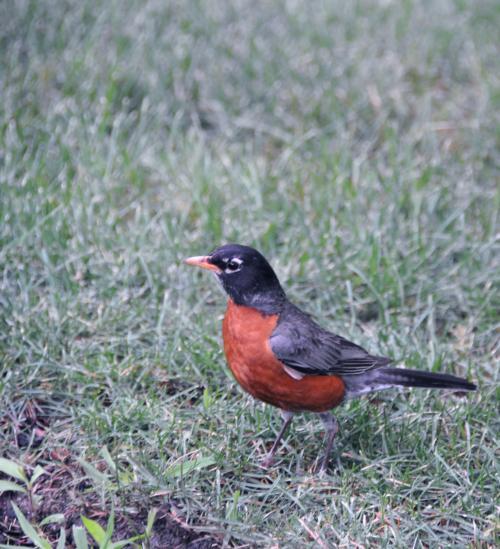
Harvard’s Birders Flock Toward Tranquility
It’s a damp autumn morning when we meet up with Ashwin H. Sivakumar ’26 — all geared up with binoculars and a backpack — on the steps of Widener Library to go birdwatching. One glance around the area and the roar of the lawn mowers in Harvard Yard tells us that the area is unfit to get any good sights of birds. So, Sivakumar suggests that we take a trip to one of the hottest birdwatching sites in Cambridge: Mt. Auburn Cemetery. It is here that Harvardian birders can seek out the joys of nature undisturbed. These simple moments with nature can remind us of the quiet wonder all around, even amid the chaos.
On our walk, Sivakumar points out blue jays, robins, black-capped chickadees, and white breasted nuthatches — all of which are native to New England. As we walk through the autumn foliage, Sivakumar stops us frequently to listen and look for birds that he knows just by their call.
“Patience is key,” he advises as he points out a blue jay. “It’s very easy to become overwhelmed.”
“So, focus on a bird,” he adds. “Don’t obsess over putting a name to the bird. Putting a name to the bird is part of the process. As you get to know these birds, you put names to them, and that helps you understand them, and that helps you identify what you're seeing in the field with something that is more broadly known.”
Sivakumar is not the only Harvardian to frequent Mt. Auburn Cemetery. Kirkland House Resident Dean Jack C. Huguley travels there often with groups of students on birding expeditions. According to Huguley, birding is an accessible activity for students that doesn’t require a great deal of preparation.
“If you are intentional enough to look up and pay attention, you can see all sorts of stuff without having to necessarily go do a special trip,” he tells us.
Huguley himself got into birding casually. While taking walks with his wife along the Charles River, he began noticing the subtle ways in which different bird species appear and disappear as the seasons change. Now, he says, he’s always on the lookout.
“When I’m walking from my apartment to the dining hall or to my office, I’m listening and hearing. I can hear a bird and know who’s in the neighborhood, who’s come through that week, or who’s especially active,” Huguley says. “And I’ll notice that as I’m just walking around, moving through the world.”
For Nina M. Foster ’23, who fostered a love for birding through the course Biology and Diversity of Birds, which she took during her junior spring, the passion has remained valuable to her past her days at Harvard. Foster writes in an emailed statement that she can still remember the class trip to the North Shore of Massachusetts where she met her “spark bird” — the downy woodpecker. Organismic and Evolutionary Biology Professor Scott V. Edwards ’86, who taught the class, was able to identify the woodpecker’s call from just one note. Captivated, Foster has been birding ever since.
“At Harvard, birding offered a break from homework, exams, and the many transitions that come with your early twenties,” Foster writes. “It allowed me to connect with a community of passionate birders who introduced me to the opportunities mentioned earlier.”
“Everyone comes to birding for different reasons,” Foster adds. “For me, it’s a fascination with their beauty and behavior, an ecological interest in their diversity as a reflection of habitat health, and an invaluable opportunity to be mindful and connect with nature.”
For Sivakumar, birding has a similar effect: “It does shift the focus away from the humdrum of daily life, and it puts my life in perspective, there’s this whole other world out there,” he says. “It really is the acquaintanceship with a new world, you realize that you share the earth with this vast range of love,” he tells us.
Huguley emphasizes that this “new world” is often right in our backyard.
In Kirkland House alone, Huguley says that there can be up to 30 different bird species each year, passing by as they continue their journeys to far-off destinations. According to Huguley, there is something to be enjoyed about the fleeting nature of these creatures — which he characterizes as a ”wonderful little moment where we get to have them all to ourselves, and we get to experience how beautiful they are.”
This beauty is everywhere, says Huguley. “Look up at the Lowell Spire every now and again, because there’s a family of red-tailed hawks that you’ll see pretty frequently,” Huguley advises. “And just those little things are so special that it doesn’t have to be a rare bird to be exciting.”
Huguley recommends Tercentenary Theater for birding, especially during late April, when birds are migrating north. He also points out the peregrine falcons that live on Memorial Hall.
“Don’t forget to look up,” Huguley says. “They’re all around you all the time, and they’re just waiting for you to see them.”


